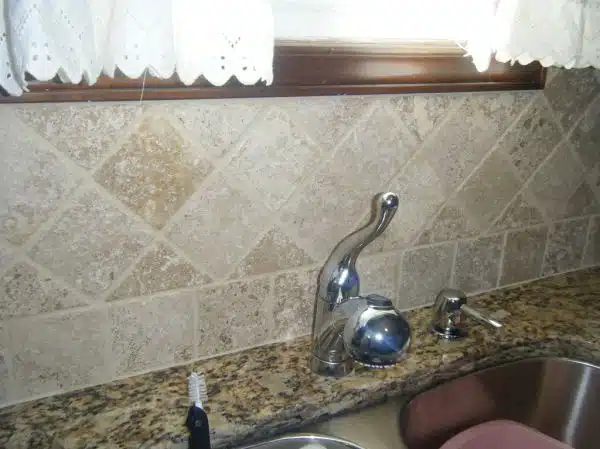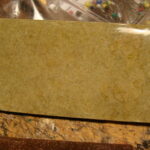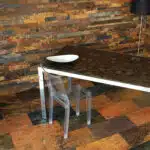As a professional in the installation of granite tile countertops, I have come across several homeowners who desire to install these countertops but lack the technical know-how. Installing granite tile countertops is a task that requires precision and attention to detail, which is why it is essential to understand the necessary steps involved in this process. In this article, we will delve into the various steps required to install granite tile countertops effectively.
Granite tiles are an excellent option for homeowners seeking a stylish and durable countertop option. These tiles are versatile, resilient, and come in a range of colors and patterns that can suit any kitchen décor. However, installing granite tile countertops requires careful planning and preparation to ensure a smooth installation process. In this article, we will provide you with an expert guide on how to install granite tile countertops successfully. Whether you are a DIY enthusiast or seeking professional help, this article will equip you with the necessary knowledge to achieve your desired results.
Measuring The Space For Granite Tile Countertops
Proper measuring accuracy is paramount when installing granite tile countertops. Before you begin, ensure that you have all the necessary tools on hand, including a tape measure, level, and straight edge. Begin by measuring the length and width of your countertop space, noting any irregularities or deviations from a perfectly square shape.
Adjusting for irregularities is crucial in ensuring an accurate measurement of your countertop space. If there are any bumps or depressions in the surface that will affect the placement of your granite tiles, be sure to take those into account when measuring. Additionally, if your walls are not perfectly straight or parallel, make note of any variations so that you can adjust accordingly.
Once you have taken all relevant measurements and adjusted for any irregularities in the countertop space and surrounding walls, you can move on to choosing the right granite tiles for your countertops. Keep in mind that this step requires careful consideration as it will ultimately determine the appearance and durability of your finished product.
Choosing The Right Granite Tiles For Your Countertops
Now that you have accurately measured your countertop space, the next step is to choose the right granite tiles for your countertops. One of the main advantages of granite tile countertops is their durability. Granite is a natural stone that can withstand high temperatures, scratches, and stains. It is also easy to clean and maintain. These qualities make granite tiles an excellent choice for kitchen or bathroom countertops.
When choosing between granite tiles and slabs, cost is a significant factor to consider. Granite tiles are more affordable than slabs because they require less material and labor to manufacture. However, it’s essential to note that installation costs may vary depending on the complexity of your countertop design. On average, you can expect to pay $50-$100 per square foot for granite tile countertops, while slabs can cost upwards of $100 per square foot.
To ensure the success of your granite tile countertop project, it’s crucial to prepare the surface adequately before installation. This involves removing any existing countertops or debris from the area and ensuring that the surface is level and stable. Additionally, don’t forget to seal your granite tiles before installation to protect them from moisture and stains. With these preparations in place, you’ll be ready to move onto the next step of installing your beautiful new countertop surface.
Preparing The Surface For Installation
Before installing granite tile countertops, preparing the surface is crucial to achieving a quality finished product. The first step in this process is thorough surface cleaning. This involves removing any dirt, debris, grease or stains that may be present on the countertop. Cleaning can be done using a mild detergent, water and a soft cloth or sponge.
Once the surface has been thoroughly cleaned and dried, it’s time to begin sealing techniques. Sealing helps to protect the granite tiles from moisture and stains while also enhancing their color and shine. Prior to sealing, ensure that the countertop is completely dry and free of any residue from cleaning products.
To ensure proper surface preparation for granite tile installation, here are some tips to keep in mind:
- Use a pH-neutral cleaner when cleaning the surface.
- Avoid using abrasive cleaners or scrubbers that could scratch or damage the surface.
- Allow sufficient time for the surface to dry completely before proceeding with sealing.
- Apply sealant evenly across the entire countertop using a clean cloth or brush.
With these tips in mind, preparing your granite tile countertop surface will be a breeze. Next up, gather all necessary tools and materials for installation.
Gathering Necessary Tools And Materials
After preparing the surface, it is time to choose the right granite tiles for your countertops. When selecting granite tiles, you need to consider a few important factors such as color and pattern, size and thickness. Granite comes in different colors and patterns, so it is essential to choose a color that complements your kitchen décor. Some popular colors include black, white, gray, brown, and red.
Another factor to consider when choosing granite tiles is the size and thickness of the tiles. The standard size for granite tiles is 12 inches by 12 inches or 18 inches by 18 inches. However, you can also find larger sizes if you prefer a more seamless look. As for thickness, most granite tiles are around 1/4 inch thick. However, thicker tiles may be necessary if you plan on using them as a countertop.
Once you have chosen the right granite tiles for your countertop project, it’s time to gather the necessary tools and materials. There are budget-friendly options available if you’re willing to put in some effort into finding them. You can save money by purchasing used tools or renting them instead of buying new ones. For materials such as adhesive and grout, consider eco-friendly alternatives that are better for the environment without sacrificing quality or durability.
When cutting granite tiles to size, precision is key. We will discuss this in detail in the next section about cutting granite tiles to size. By following these steps carefully and methodically while keeping an eye on budget-friendly and eco-friendly options where possible throughout the process of installing your own beautiful granite tile countertops will provide both satisfaction with results achieved as well as being friendly toward our planet at large!
Cutting Granite Tiles To Size
As the saying goes, “measure twice, cut once.” This holds especially true when it comes to cutting granite tiles for your countertops. Before getting into the cutting techniques, it’s important to take safety precautions seriously. Granite is a hard and heavy material that can cause serious injury if not handled properly. Always wear protective gear such as gloves, goggles, and a dust mask.
When it comes to cutting granite tiles to size, there are two main techniques: using a wet saw or an angle grinder with a diamond blade. Wet saws are the preferred method as they produce less dust and provide smoother edges. They work by using water to cool the blade and prevent overheating. Angle grinders are best suited for small cuts or shaping edges but can be messy due to the amount of dust they create.
Regardless of which technique you choose, always begin by marking your cut lines on the tile with a pencil or marker. Use a straight edge or square to ensure accuracy. Take your time and make small cuts rather than trying to make one large cut all at once. Remember to keep safety in mind throughout the entire process.
Transitioning into creating a layout for your countertops, it’s important to have an idea of how you want your countertop to look before beginning any cutting or installation work. This includes deciding on the size and shape of each individual tile as well as how they will fit together as a whole. By taking time in the planning stage, you’ll save yourself headaches down the road during installation.
Creating A Layout For Your Countertops
Now that you have successfully cut your granite tiles to the desired size, it is time to create a layout for your countertops. Creating a layout helps in determining the exact placement of each tile and ensures that the final design looks cohesive. Start by measuring the countertop area and marking it out on the surface. This will give you an idea of how many tiles you will need and where they should be placed.
When choosing the design for your granite tile countertops, consider factors such as color, pattern, and texture. Granite comes in a wide range of colors and patterns, so take some time to browse through different options before making a decision. You may also want to consider adding decorative tiles or borders to enhance the overall look of your countertops.
Once you have chosen the design and created a layout, it is time to move on to applying adhesive to the surface. This step is crucial as it ensures that your tiles stay firmly in place. In the next section, we will discuss how to apply adhesive properly and give tips on how to avoid common mistakes when installing granite tile countertops.
Applying Adhesive To The Surface
First and foremost, before applying any adhesive, it is important to properly prepare the surface of the countertop. This includes cleaning it thoroughly with soap and water, drying it completely, and ensuring there are no bumps or uneven spots that could affect the tile placement. Once the surface is ready, you can move on to selecting the right type of adhesive for your particular project.
There are several types of adhesives commonly used for granite tile countertops, including epoxy, mastic, and mortar. Each type has its own unique properties and benefits, so it is important to choose one that will work best for your specific needs. Some factors to consider include the size and weight of the tiles, as well as the environment in which they will be installed.
When applying adhesive to the surface of a granite tile countertop, there are a few common mistakes that should be avoided. For example, using too much adhesive can cause tiles to shift or slide out of place during installation. Additionally, failing to properly mix or apply the adhesive can result in an uneven surface that will be difficult to correct later on. If you encounter any issues during application or notice problems after installation, there are several troubleshooting techniques you can use to address them.
- Types of Adhesive:
- Epoxy
- Mastic
- Techniques for Applying Adhesive:
- Use a notched trowel
- Apply the adhesive evenly across the surface
- Common Mistakes:
- Using too much adhesive
- Improper mixing/application
- Troubleshooting Techniques:
- Remove excess adhesive with a razor blade
- Adjust tiles while still wet
As you finish applying adhesive onto your granite tile countertop’s surface,it is important to remember that laying each tile precisely will be easier if you take extra time in preparation.A clean work environment free from clutter will enable smooth movement around your workspace without hindering progress.The next section will cover the process of laying the granite tiles on top of the adhesive.
Laying The Granite Tiles
Prior to laying the granite tiles, it is important to properly prepare the surface by cleaning and leveling it, as this will ensure that the tiles are properly adhered.
Once the surface is ready, it is time to apply the adhesive. A high-quality, water-resistant adhesive should be used to ensure that the tiles stay securely in place.
The adhesive should be applied evenly across the entire surface using a notched trowel, taking care to avoid creating any air pockets or leaving any gaps between the tiles.
Once the adhesive has been applied, the granite tiles can be laid, taking care to align them evenly and press them firmly into the adhesive.
Preparing The Surface
To achieve a successful granite tile countertop installation, one must start with proper surface preparation. The first step in preparing the surface is to ensure that it is level and smooth. This can be achieved by removing any bumps or lumps on the countertop using a leveling compound. It is also important to check for any cracks or chips in the surface and repair them before proceeding.
Once the surface has been leveled, the next step is surface cleaning. This involves removing any debris, dirt or grease that may be present on the countertop. A mixture of warm water and mild soap can be used to clean the countertop thoroughly. After cleaning, rinse off with clean water and dry completely using a towel.
After completing both steps of surface preparation, you are now ready to lay your granite tiles on your countertop. Remember that proper preparation of the surface ensures that your granite tile installation will last for years to come without encountering any problems caused by improper adhesion due to an uneven or dirty surface.
Applying The Adhesive
Now that the surface has been properly prepared, it is time to move on to the next step of laying the granite tiles. Using the right adhesive is crucial in ensuring a successful installation. There are various types of adhesives available in the market, but it is important to choose one that is specifically designed for granite tiles.
Properly applying the adhesive is equally important as choosing the right type of adhesive. The first step in applying the adhesive is to spread a thin layer evenly over the countertop using a notched trowel. Be sure to work in small sections at a time and avoid spreading too much adhesive as this can cause unevenness and difficulty in placement.
Once you have applied the adhesive, carefully lay each tile onto the surface making sure it fits snugly against one another. It is essential to start from one end and work towards the other while checking for alignment and ensuring that each tile sits level with one another. Remember to wipe off any excess adhesive immediately before it dries up. With proper application, your granite tile countertop will now look seamless and stunning!
Filling In The Grout Lines
After laying the granite tiles, the next step is to fill in the grout lines. One of the most popular and efficient ways to do this is by using epoxy grout. Epoxy grout is a two-part adhesive that consists of epoxy resin and hardener. It’s incredibly durable and resistant to stains, making it a suitable option for high-traffic areas like kitchens.
To start filling in the grout lines with epoxy grout, first, mix the two components together according to the manufacturer’s instructions. Then, use a rubber float to apply the mixture into the joints between each tile. Make sure to work in small sections and scrape away any excess grout before it dries. Once you’ve filled in all the joints, let it dry for about 10-15 minutes before wiping away any remaining haze with a damp sponge.
After filling in the grout lines, sealing them is crucial for protecting your countertops from moisture and stains. A sealer will penetrate deep into the pores of your granite tiles’ surface, creating a protective barrier that repels water and other liquids. Sealers are available in different types, including penetrating sealers or impregnators that protect against oil-based stains while still allowing your countertop to breathe.
| Pros | Cons |
|---|---|
| Durable | Difficult to remove once applied |
| Stain-resistant | Can be expensive |
| Low maintenance | Time-consuming application process |
With epoxy grout and proper sealing techniques, you can maintain your granite tile countertops’ longevity and appearance for years to come. In the next section, we’ll discuss how to install sink and stove cutouts without damaging your newly installed countertops.
Installing Sink And Stove Cutouts
Cutting sink and stove cutouts can be a crucial step in installing granite tile countertops. It’s important to use the right cutting techniques and take necessary safety precautions to avoid any accidents. One of the most commonly used cutting techniques for sink and stove cutouts is using a diamond blade saw.
Before starting with the cutting process, it’s essential to ensure that all appliances are disconnected from the power source, and the workspace is clear of any obstacles. A template is then placed on top of the countertop to mark out where the cutout will be made. Then, using a diamond blade saw, carefully make cuts along the marked lines. It’s crucial to keep your hands away from the blade and wear protective gear such as gloves, goggles, and earplugs.
After completing the cutouts for sinks and stoves, it’s essential to clean up any debris left behind. Check that both appliances fit securely into their respective cutouts before moving onto sealing the granite tiles surrounding them. Taking these safety measures while cutting ensures that you have a precise and safe installation process for your granite tile countertops.
Sealing The Granite Tiles
- Cleaning the granite tiles is an important step to ensure the proper adhesion of the sealant.
- Tiles should be thoroughly wiped down with a damp cloth to remove any dust and debris before applying the sealant.
- The sealant should be applied using a brush or roller in a thin, even coat, making sure to cover all of the tiles.
- Once the sealant has been applied, it should be left to cure for 24 to 48 hours before the countertop is used.
- During the curing process, the area should be kept free of dust and other debris to ensure a successful seal.
- After the sealant has cured, the countertop should be cleaned with a damp cloth and the tiles should be sealed once more to ensure longevity.
Cleaning The Tiles
When it comes to sealing granite tiles, cleaning is an essential aspect that cannot be ignored. To achieve a lasting and shiny finish, it is crucial to ensure that the tiles are properly cleaned before applying any sealant. Tips for effective cleaning include wiping down the surface with a damp cloth to remove any dirt or debris. Avoid using harsh chemicals as they can damage the surface of your granite tiles, leaving them dull and unappealing.
To achieve optimal results during your cleaning routine, you should use recommended cleaning products such as pH-neutral cleaners. These cleaners are gentle on the surface of the granite tile countertops and effectively break down grease and grime without causing any damage. In addition to this, it is crucial to avoid abrasive sponges or pads when cleaning your countertops as they can cause scratches on the surface of your tiles and compromise their integrity.
In conclusion, maintaining a clean surface is critical when installing granite tile countertops in your home. With proper care and maintenance, you can extend the lifespan of your countertops while ensuring that they remain aesthetically appealing for years to come. Remember to use recommended cleaning products and techniques for effective cleaning without damaging the surface of your granite tiles.
Applying The Sealant
When it comes to sealing granite tiles, applying the sealant is a crucial step that follows after thorough and effective cleaning. Choosing the right sealant for your specific type of granite tile countertops is essential in ensuring optimal protection against stains, scratches, and other damages. It is recommended to use a high-quality penetrating sealant as it soaks into the pores of the tiles, providing long-lasting protection.
Before applying the sealant, it is essential to ensure that the surface is completely dry and free from any debris or dirt. For best results, use a microfiber cloth or sponge to apply the sealant evenly over the surface of your granite tile countertops. Ensure that you cover all areas of the tiles with an even layer of sealant to avoid any spots or patches.
After applying the sealant, allow it to cure for at least 24 hours before using your granite tile countertops again. This curing time allows the sealant to penetrate deep into the pores of your tiles and create a protective barrier against spills and scratches. Regularly reapplying the sealant every few years will ensure lasting protection for your granite tile countertops while maintaining their luster and appeal.
Curing The Sealant
Curing the sealant is an essential step in the process of sealing granite tiles. After applying the sealant, it is crucial to wait for it to cure completely before using your granite tile countertops again. The importance of patience cannot be stressed enough when it comes to curing the sealant. Rushing this process could result in a weak protective barrier that is susceptible to damage from spills and scratches.
Choosing the right sealant goes hand-in-hand with curing the sealant. It is recommended to use a high-quality penetrating sealant that will soak deep into the pores of your tiles, providing long-lasting protection against stains and other damages. A good quality sealant combined with proper curing time will ensure maximum protection for your granite tile countertops.
It is important to note that regular maintenance and reapplication of the sealant every few years will help maintain the luster and appeal of your granite tile countertops while ensuring lasting protection against stains and scratches. With patience during curing time and choosing the right sealant, you can enjoy beautiful and protected granite tile countertops for years to come.
Polishing The Countertops
Achieving a smooth and polished surface is the hallmark of any successful granite tile countertop installation project. Polishing your countertops can be done by either a professional or through a DIY approach, depending on the level of expertise you possess. While hiring an expert can guarantee great results, it can also be pricey. However, with the right tools and techniques, you can achieve stunning outcomes by polishing your granite tile countertops yourself.
Polishing tools and techniques vary depending on the type of granite tile used for your project. Diamond polishing pads are commonly used to create a smooth and glossy finish on granite surfaces. Depending on the level of shine you desire, you may need to use different grits of diamond polishing pads to achieve optimal results. Other tools that may come in handy include angle grinders, sanders, or buffing machines.
When polishing your granite tile countertops, it’s important to take extra caution not to damage the surface. Start by cleaning the surface thoroughly before applying any polish compound. You should then work systematically across each section of the countertop using gentle yet firm pressure while monitoring progress closely. With patience and persistence, you’ll achieve a smooth and polished surface that will last for years to come.
Maintaining a clean and polished surface is key in keeping your granite tile countertops looking their best over time. In the next section, we’ll explore some tips on how to keep your countertops free from dirt and stains while preserving their natural beauty.
Cleaning And Maintaining Your Granite Tile Countertops
Once your granite tile countertops are installed, it is important to properly clean and maintain them in order to keep them looking their best. The first step in maintaining your countertops is using the best cleaners for granite. Harsh chemicals should be avoided as they can damage the sealant on the surface of the countertop. Instead, opt for cleaners that are specifically designed for use on granite surfaces.
Stain prevention is also an important aspect of maintaining your granite tile countertops. While granite is a durable material, it is not completely stain-proof. To prevent stains from occurring, wipe up spills as soon as possible and avoid leaving acidic liquids like lemon juice or vinegar sitting on the countertop for long periods of time. If a stain does occur, there are specific cleaning products available that can help remove it without damaging the countertop.
Regular cleaning and maintenance will go a long way in keeping your granite tile countertops looking beautiful for years to come. In addition to using the right cleaners and preventing stains, it is recommended that you seal your countertops every six months to protect against damage and wear. By following these simple steps, you can ensure that your investment in granite tile countertops will continue to pay off for many years to come.
As with any home improvement project, there may be issues that arise during or after installation of your granite tile countertops. In the next section, we will discuss some common troubleshooting tips for these issues so that you can quickly and easily address any problems that may arise.
Troubleshooting Common Installation Issues
Cracked tiles can be caused by improper installation techniques or an uneven surface. To avoid this issue, it is important to use the proper tools and techniques for installation. Grout discoloration can occur if the grout is not sealed properly or if the wrong type of grout is used. Additionally, selecting grout colors that match the surrounding tile material will help to retain the desired look.
Cracked Tiles
Cracked tiles can be a frustrating issue that many homeowners encounter during the installation of granite tile countertops. These cracks can occur due to various reasons, such as improper installation or accidental damage during transportation. Repairing these cracks is necessary to prevent further damage and maintain the aesthetic appeal of the countertop.
To repair cracked tiles, start by removing the damaged tile carefully. Next, clean the area and apply an epoxy adhesive that matches the color of the granite. Place the replacement tile carefully and ensure it is level with the surrounding tiles. Once set, use a sealant to ensure it blends in with the rest of the countertop seamlessly. Preventing future damage can be achieved by hiring an experienced installer who follows proper installation techniques and using high-quality materials.
Prevention is always better than cure when dealing with cracked tiles on granite tile countertops. Homeowners need to take extra care when handling heavy objects on their countertops and avoid placing hot pots or pans directly onto them. Regular maintenance such as sealing and cleaning should also be carried out to keep the granite in good condition for years to come. By taking these precautionary measures, homeowners can avoid costly repairs down the line while enjoying their beautiful granite tile countertops for years to come.
Grout Discoloration
Another common issue that homeowners encounter during the installation of granite tile countertops is grout discoloration. This can be frustrating as it can affect the overall aesthetic appeal of the countertop. Grout discoloration can occur due to various reasons such as improper cleaning or using the wrong cleaning products. As an expert in granite tile countertop installation, it is essential to troubleshoot and prevent this issue.
Preventing grout discoloration starts with proper installation techniques. Ensure that the grout is mixed correctly and applied evenly between tiles. After installation, it is crucial to seal the grout to prevent any moisture from penetrating and causing discoloration. Regular maintenance such as cleaning with a mild detergent solution and warm water should also be carried out to keep the grout looking clean and fresh.
If grout discoloration occurs, it is essential to act quickly before the stains become permanent. Begin by cleaning discolored grout with a mixture of baking soda and water or vinegar and water solution. Scrub gently using a soft-bristled brush until the stains are removed. If this method does not work, consider using a commercial grout cleaner specifically designed for your type of tile and grout. Remember always to test any new product on a small inconspicuous area before applying it all over.
By troubleshooting and preventing issues such as cracked tiles or grout discoloration, homeowners can ensure that their granite tile countertops look beautiful for years to come. As experts in installation, we understand how important it is to provide high-quality service while educating our clients on proper maintenance techniques. By serving others through our expertise, we aim to create lasting relationships built on trust and satisfaction.
Hiring A Professional For Installation Assistance
As an expert in granite tile countertop installation, it is important to recognize that common installation issues can arise during the DIY process. However, these issues often stem from a lack of experience or knowledge in the field. While installing granite tile countertops on your own may seem like a cost-effective solution, it is important to consider all factors before making a decision.
Cost considerations should always be factored into any home renovation project. While DIY installation may appear cheaper upfront, it is important to consider the potential costs of mistakes or damages that can occur during the process. Professional installers are trained and experienced in handling these types of materials and are equipped with the proper tools and techniques to ensure that the job is done correctly the first time around.
Ultimately, when deciding whether to pursue a DIY or professional installation for your granite tile countertops, it is crucial to weigh all options and factors involved. Considerations such as budget, experience level, and availability should all be taken into account before making any final decisions. By doing so, you can ensure that your new countertops are installed properly and efficiently without causing any unnecessary stress or frustration along the way.
Conclusion
In conclusion, installing granite tile countertops requires careful planning and attention to detail. It is crucial to measure the space accurately and choose the right tiles for your needs. Preparing the surface is essential, as it ensures that the installation will be smooth and seamless.
Gathering the necessary tools and materials and cutting the tiles to size are also critical steps that require precision and skill. Polishing the countertops ensures that they look their best, while cleaning and maintaining them regularly will help prolong their lifespan.
While troubleshooting common installation issues can be challenging, seeking professional assistance can ensure that any problems are resolved quickly and effectively. As a granite tile countertop installation expert, I recommend taking your time with this process to ensure that you achieve beautiful, durable countertops that enhance your home’s aesthetic appeal.
Image Credits
- “Santa Cecilia Granite Countertops with Tile Backsplash in Charlotte” by granite-charlotte (featured)





























